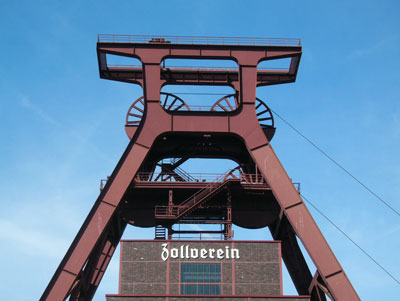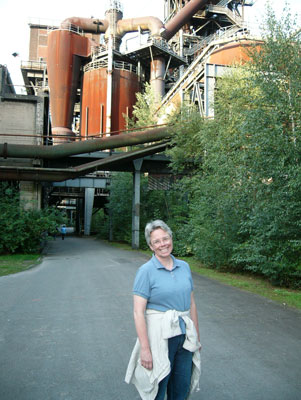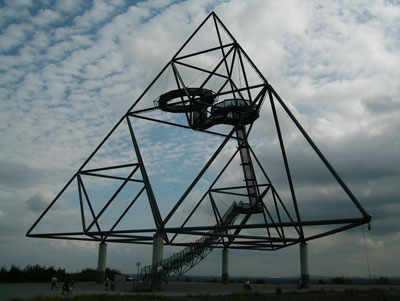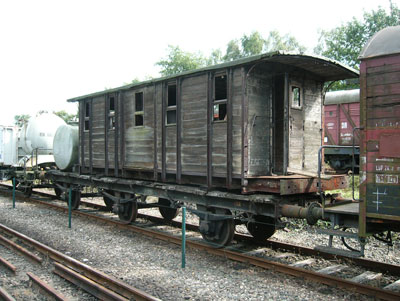Colossal industrial reminders await visitors to Germany's Ruhrgebiet
by Martha Wiley, Landstuhl, Germany
My husband, Karl, and I had a fantastic visit to the Ruhrgebiet in Germany over Labor Day weekend (Sept. 2-8) 2008. Gebiet (pronounced G’beet) means “area,” but this area is informally known as the Ruhrpott (I’m not sure why). Located around the Ruhr River in western Germany, this has been a highly industrialized area, since the start of the Industrial Age, with a number of coal mines, steel factories and chemical plants.
The Ruhrgebiet has been designated a European Capital of Culture for 2010 (www2.ruhr2010.de), and many cultural events are being scheduled for that year, so it would be a great time to visit. Major building projects were begun in 2008 to prepare for the celebration, including a new building to house the Museum Folkwang in Essen, the redevelopment of an old brewery tower (known as the “Dortmund U”) into an exhibition center for contemporary art, and an extension to the Küppersmühle Museum of Modern Art in Duisburg.
Not very many Americans travel to this area. When I mentioned to a German friend that we were thinking of going, her response was, “Why would you want to?” But I think it is a fascinating area that shows a lot about the industrial part of Germany that was and still is a vital segment of the country’s history and culture. After all, you can visit only so many cathedrals and art museums before they all start to become a blur.
Planning a visit
The Pott contains the cities of Duisberg, Essen, Dortmund and Düsseldorf as well as other smaller cities and towns. Individually, these cities are not so large (Dortmund is the largest and it’s only the seventh-largest city in Germany), but together they form the second-largest metropolitan area in continental Europe, after Paris.
Most people go to the Gebiet for work, so over the weekend you can get some exceptional deals. We got a special on the train ticket from Frankfurt to Essen on Deutsche Bahn (www.bahn.de) — only $117 round trip for both of us for the journey (five hours each way).
My usual hotel-booking site (www.booking.com) didn’t offer much for the Ruhr area, so I used www.bedandbreakfast.de to find an apartment in Essen (lodging No. 106700) with a full kitchen, a living room, bedroom and bath, all completely furnished. It wasn’t luxurious, but the water was hot and the beds were comfortable (€35, or $50).
We used Google Maps to show us the way from Essen’s Hauptbahnhof (train station) to the apartment.
We did all our travel on the local transit system, Verkehrsverbund Rhein-Ruhr, or VRR (www.vrr.de), which was incredible. We bought several day passes (€10 per adult) that allowed us to use commuter trains, streetcars, undergrounds and buses — everything but taxis — so we could travel as much as we wanted from Essen, which is in the middle, to the cities on the outskirts.
We relied primarily on a small guidebook called “Tour the Ruhr” by Roy Kift (www.roy-kift.com).
Getting there
The train journey to Essen from Frankfurt followed the Rhine River, along the part known as the “Romantic Rhine.” The river winds through steep-sided hills with grapevines growing in parallel vertical rows and small patches of green, quilt-like squares. Gray basalt cliffs rise above, and restored medieval and Renaissance castles perch on top, flying strings of colorful flags. It’s a very castle-y stretch of river. I had my nose pressed against the glass of the train window trying to see everything.
As the train pushed northward, three tall smokestacks across the river disturbed the romance and served as harbingers of our destination. We passed through Koblenz at the Rhine’s confluence with the Mosel, then Köln, where the train station sits immediately adjacent to one of the greatest Gothic cathedrals in Europe.
We arrived at Essen in the late afternoon. As we walked the half-kilometer to our apartment, we saw a lot of racial diversity and heard languages from Africa and Asia as well as German and the local dialect, Ruhrsprache. The city is grittier than any other German city we’ve been in, with more graffiti and empty shop windows and fewer black and silver Mercedes and Audis and more red and blue VWs and Fords.
The Ruhrpott was the center of Germany’s military industrial complex during both World Wars, so it suffered heavy damage both times. Nevertheless, with the help of the Marshall Plan, the area had its heyday in the 1950s and ’60s when Kohl (coal) was still König (king) and before environmental concerns were raised about air and water pollution.
Nowadays, although there is still a lot of heavy industry, it is much cleaner. (As our guidebook said, “The Pott is no longer so black.”) Canals and rivers are relatively pure, there are lots of trees, and air pollution is unnoticeable. The old factories that were closed have been put to other, much more pleasant, uses, such as parks and museums.
Museum visits
As coal formed the basis of industry in the region for a hundred years or more, it seemed only fitting that we see a coal mine.
The Deutsches Bergbau Museum (www.bergbaumuseum.de) in Bochum, outside Essen, is the largest mining museum in the world (according to its own literature). The U-Bahn stop is right outside its front door, so when you come up the stairs from the underground you see the museum right in front of you, looking like a veritable cathedral to the mining industry. And, just like a cathedral, three huge sets of brass half-relief doors show scenes of things considered important, in this case, elements of mining and industry. (Admission is €6.50, or $10, per adult.)
To see the underground portion of the museum, you have to take a tour. The tours, led by former miners (in German), show how coal has been mined since the start of the industrial age up to the present day but nothing about mining before 1830.
Okay, I was a little bored. But in the lobby hung an unusual chandelier made from miners’ boots and helmets, and the view from the top of the tower was great.
Note: the museum’s cafeteria had the worst food we’ve ever eaten in Germany!
After the mine museum, we set out for the Eisenbahn (railroad) museum (www.eisenbahnmuseum-bochum.de). It got good write-ups in several tour books, but I would pass this by unless you have a serious interest in historic trains.
It’s located about two kilometers from the streetcar stop and that’s a long walk. (During the summer there’s a bus, but not on the day we went.) Still, it was interesting to see the old train maps and look at the old steam engines. (Admission, €6.)
On Sunday we took a streetcar to the Zollverein (www.zollverein.de/english), a former coal-processing plant now designated a UNESCO World Heritage Site (admission, €5). As the streetcar drew nearer to the museum, we saw houses painted with Bavarian-style murals, not of deer or fields, as is usual, but of miners carrying lanterns or lunch pails.
As we walked onto the grounds, church bells echoed oddly off the 50-foot-high brick-and-metal buildings. Towering 200 feet overhead was the huge steel structure that supported the coal cars on their journey from the train cars up into the plant.
We took a tour which allowed us to get into the different areas of the plant. The guide spoke German, but there were drawings with descriptions in English along the way.
Once we reached the top of the plant, we had a fantastic view over the flat topography. We could see a hundred smoke stacks all around the area, although most of them aren’t smoking anymore.
The Zollverein Landfrauen (a women’s club) sold snacks at a little outdoor stand. They specialized in small, very black rolls called Kohlebrötchen (coal rolls), made with octopus ink. They also had Ruhrpott Tapas, slices of coal bread spread with butter, and Frickadelle, cold meat patties that tasted like leftover meatloaf. We ate lunch there, outside in picnic fashion, and it was very good. Lunch for two with soda cost €7.
Mondays in the Ruhrpott
Mondays offer special challenges for visitors, as many museums and exhibits in Germany are closed on that day. Research showed that we had a few options, though, so we set out by train and bus for the Tetraeder (free admission) in Bottrop.
The Tetraeder is a 200-foot-high triangular sculpture on the top of a mine-waste hill, and it’s visible on the horizon from most other high points around the region. Winded after our climb up the 500-foot-high hill from the bus stop, we were dismayed to see a workman hanging a “Geschlossen” (“Closed”) sign on the steps that allow visitors to climb up into the structure. I ran over and pleaded with him and he fell for it.
“Fifteen minutes only, and be sure to hang the ‘Closed’ sign up when you leave,” he said sternly.
So up we went. The stairs and platforms within the tetrahedron are open metal work, so I had a tricky time trying not to look down at my feet (and thence to the ground). There are straight and spiral stairs and platforms, all hanging by wire from the open metal structure. This allows them to swing in the wind, which was considerable. But the view from the top was fantastic.
Duisburg
Our next planned stop was Duisburg. We intended to go to the North Duisburg Landscape Park but got sidetracked when I read in the guidebook that Duisburg has the largest inland harbor in Europe.
We walked down to the Schwanentor in central Duisburg to take a look and saw a Weisse Flotte boat (www.wf-duisburg.de; website and tour in German) boarding for a harbor tour (€11 per adult). We made it just before they cast off. I highly recommend it — two hours of gliding along canals, rivers and harbors with beer and snacks and, best of all, sitting down!
Back at the Schwanentor, we felt the need for coffee and cake, notwithstanding the beer we had on the boat tour! (This is how we travel, with a stop for food or drink every two hours.) The Caféhaus Dobbelstein (Sonnenwall 8) was just the thing.
Although they had outside seating, the best ambience was inside, where the walls, two stories up, were covered with a collection of coffee grinders and mills. They had lovely cakes and candies, and Karl said the coffee was some of the best he’d ever had. Tea and coffee plus cakes for two cost €10.
In the late afternoon we made it to the North Duisburg Landscape Park (www.landschaftspark.de), which is open 24 hours so we knew we didn’t have to worry about its closing. What an interesting place! A former steel mill, it’s now a gigantic playground for children and adults.
We climbed all over the old mill, which is completely open to the elements. The stairs and platforms are safely protected with sturdy handrails, and there are explanatory signs at each level. The highest you could go was 70 meters — great view!
There’s also a more traditional children’s playground, a canal for water play and all kinds of places to run around. Several of the larger buildings are now used for exhibits and concerts, and there’s a bistro near the front for snacks.
At night, on the weekends, there’s said to be a spectacular light show that lights up various parts of the industrial buildings.
We ate dinner in Duisburg at Brauhaus Schacht 4/8 (Düsseldorferstr. 21; www.brauhaus-schacht-4-8.de), named after a coal mine and located in an old bank building. We ate in the main lobby, with its 30-foot-high, ornately carved wood ceiling, huge old beams, marble columns with carved capitals and life-sized railroad tracks, complete with ties and ballast, running flat against the wall! Dinner for two with beer cost €25.
We staggered back into our apartment at about 11 p.m., exhausted after the train ride from Duisburg back to Essen.
One last day
The Villa Hügel (www.villahuegel.de) is the former home of Alfred Krupp, the industrial king of the Ruhr region. It has 259 rooms but was listed as a single-family house on the tax rolls until it was taken over by the government for state uses. It’s now a museum (admission, €3).
As a museum in its own right, frankly it wasn’t worth the time, although there are lovely park-like grounds and the building is pretty ornate with lots of carved wood. But we happened to luck out by visiting when the largest Essen art museum, the Museum Folkwang, was being moved to its new location at the Zollverein. (It is expected to open in January 2010 in time for the Culture Festival.)
Since the Zollverein wasn’t quite ready for its new tenant, the Villa Hügel stepped up and allowed many of Folkwang’s famous pieces — works by Gaugin, Monet, Picasso — to be displayed within. We just stepped in and there they were, unexpected!
All in all, this was a fascinating trip — three days of touring plus a half day’s travel in and a half day out. In 2010 things are liable to be even more interesting, with the European Capital of Culture designation and the related activities. We highly recommend a visit!




